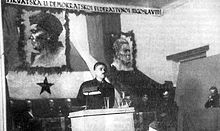Antifascist National Council for the Liberation of the People of Croatia
The Antifascist National Council of the People's Liberation of Croatia ( Croatian Zemaljsko antifašističko vijeće narodnog oslobođenja Hrvatske ), ZAVNOH for short , was founded on June 13, 1943 as the supreme body of the anti-fascist movement in Croatia during the Second World War . After the Balkan campaign (1941) and the division of the Kingdom of Yugoslavia by the Axis powers , the independent state of Croatia was established under the rule of the fascist Ustaše with a one-party dictatorship . In contrast, the ZAVNOH represented the war government in Croatia and consisted of representatives of the Croatian Peasant Party (HSS) , the Communist Party of Yugoslavia , the Communist Party of Yugoslavia , the Independent Democratic Party led by Serbs and those without party affiliation.

In September 1943, the partisan movement in Croatia under Andrija Hebrang or the ZAVNOH with around 78,000 Tito partisans , more partisans than the partisan movements in Serbia , Montenegro , Slovenia and Macedonia combined. A total of 228,474 people joined the partisan movement in Croatia between 1941 and 1945, 61 percent of them Croatians (140,124), 28 percent Serbs (63,710) and other ethnic groups ( Slovenes , Muslims , Montenegrins , Italians , Hungarians , Czechs , Jews and others Yugoslav Germans ).
history
The anti-fascist movement had already reached a considerable level of organization when the political leadership of the Tito partisans met on June 13, 1943 on behalf of the Croatian parliament ( Sabor ) for the founding session of the ZAVNOH. A large territory in Croatia was already under the control of the partisans and thousands of so-called National Liberation Committees had already been established at the local level. The number of National Liberation Committees at the municipal, district and regional level in Croatia was 677 at the end of 1941, 1,609 at the end of 1942 and 4,596 at the end of 1943.
At the meeting in Topusko near Sisak in May 1944, the ZAVNOH declared itself to be the supreme legislative and executive body of the Croatian state of the new " Democratic Federal Yugoslavia ". In May 1944, 1,350 primary schools with 90,000 pupils and more than 2,300 teachers , 30 universities and 20 publishers were subordinate to the ZAVNOH , which produced 270 series. After taking over the capital Zagreb on May 8 and 9, 1945, the council moved there. At its last meeting, the decision was made to designate ZAVNOH as Narodni sabor Hrvatske (People's Parliament of Croatia) in future .
Meetings
1st session
- June 13, 1943 in Otočac and June 14, 1943 at the Plitvice Lakes .
Vladimir Nazor was elected chairman. The high-ranking partisan leader Milovan Đilas attended this meeting and later wrote about it:
“ Nowhere has a power structure been so striking and so real as in this liberated area. This became evident not only in the better clothing and food of the employees and agencies, but also in the official, bureaucratic way of working. ZAVNOH [...] had every appearance of an assembly and a government. [...] All kinds of schools were run; Agencies exchanged reports and circulars. "
2nd session
In his opening speech, the high-ranking partisan leader Moša Pijade emphasized above all the extensive participation of the Croatian intelligentsia in the partisan movement in Croatia and stated that there was almost no such participation in Serbia . Only a small number joined the resistance in Belgrade . In addition, the will Gestapo - prison Glavnjača operated by the same criminals and executioners, the infamous prison already at the time of the Kingdom of Yugoslavia had operated.
3rd session

- May 8 and 9, 1944 in Topusko
On May 9, 1944, the ZAVNOH declared itself the highest legislative and executive body of the Croatian state of the new Democratic Federal Yugoslavia . At that time, the ten-member presidium of the ZAVNOH consisted of three representatives of the Croatian Peasant Party HSS ( Franjo Gaži , Stjepan Prvčić , Filip Lakuš ), two representatives of the Communist Party of Yugoslavia KPJ (Andrija Hebrang, Ivan Gošnjak ), two representatives of the Serbian cooperating with the HSS Independent Democratic Party (party leaders Rade Pribičević , Simo Eror ) and three independent representatives without party affiliation (Catholic priest Svetozar Ritig , writers Vladimir Nazor, Ante Mandić ).
4th session
- August 21, 1945 in Zagreb (in the building of the Croatian Parliament)
Individual evidence
- ↑ At this point in time, 13,000 in Serbia, 10,000 in Montenegro, 21,000 in Slovenia and 10,000 in Macedonia. See Vlado Strugar: Jugoslavija 1941–1945 . Vojnoizdavački zavod, Belgrade 1969, p. 69, 219, 318 . and Nikola Anić, Sekula Joksimović, Mirko Gutić: Narodnooslobodilačka vojska Jugoslavije . Ed .: Vojnoistorijski institut. Belgrade 1982, p. 69-86, 113, 199, 209, 279, 301, 332, 348 f., 368, 378, 387, 457, 468, 536-540 .
- ^ Ivan Jelić: Hrvatska u ratu i revoluciji 1941–1945 . Školska knjiga, Zagreb 1978, p. 304 .
- ^ Ivan Jelić: Hrvatska u ratu i revoluciji 1941–1945 . Školska knjiga, Zagreb 1978, p. 291 .
- ↑ a b Collection of the decisions of the ZAVNOH (Croatian; pdf), pp. 17–20.
- ↑ Fabijan Trgo: Zbornik dokumenata i podataka o narodnooslobodilačkom ratu jugoslovenskih naroda. : Borbe u Hrvatskoj 1944. godine . Vojnoistorijski institut, Belgrade 1964, p. 370 .
- ↑ Milovan Djilas: Wartime . Harcourt Brace Jovanovich, New York 1977, pp. 314 .
- ↑ Ivan Supek: Krivovjernik na ljevici . Globus, Zagreb 1992, p. 111 .
- ^ Zvonko Ivanković-Vonta: Hebrang . Bibliotheca Scientia Yugoslavica, Zagreb 1988, p. 255 .

